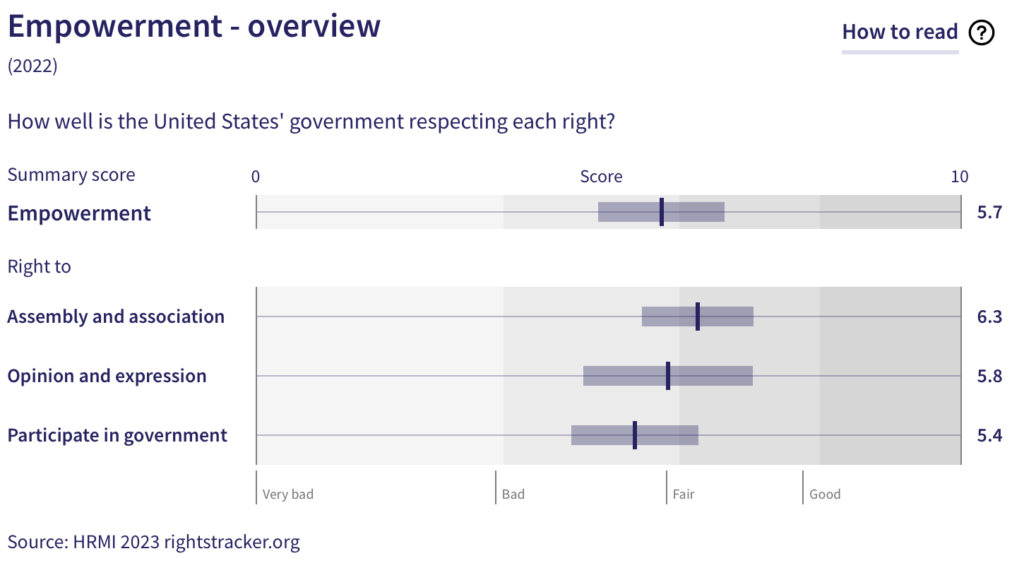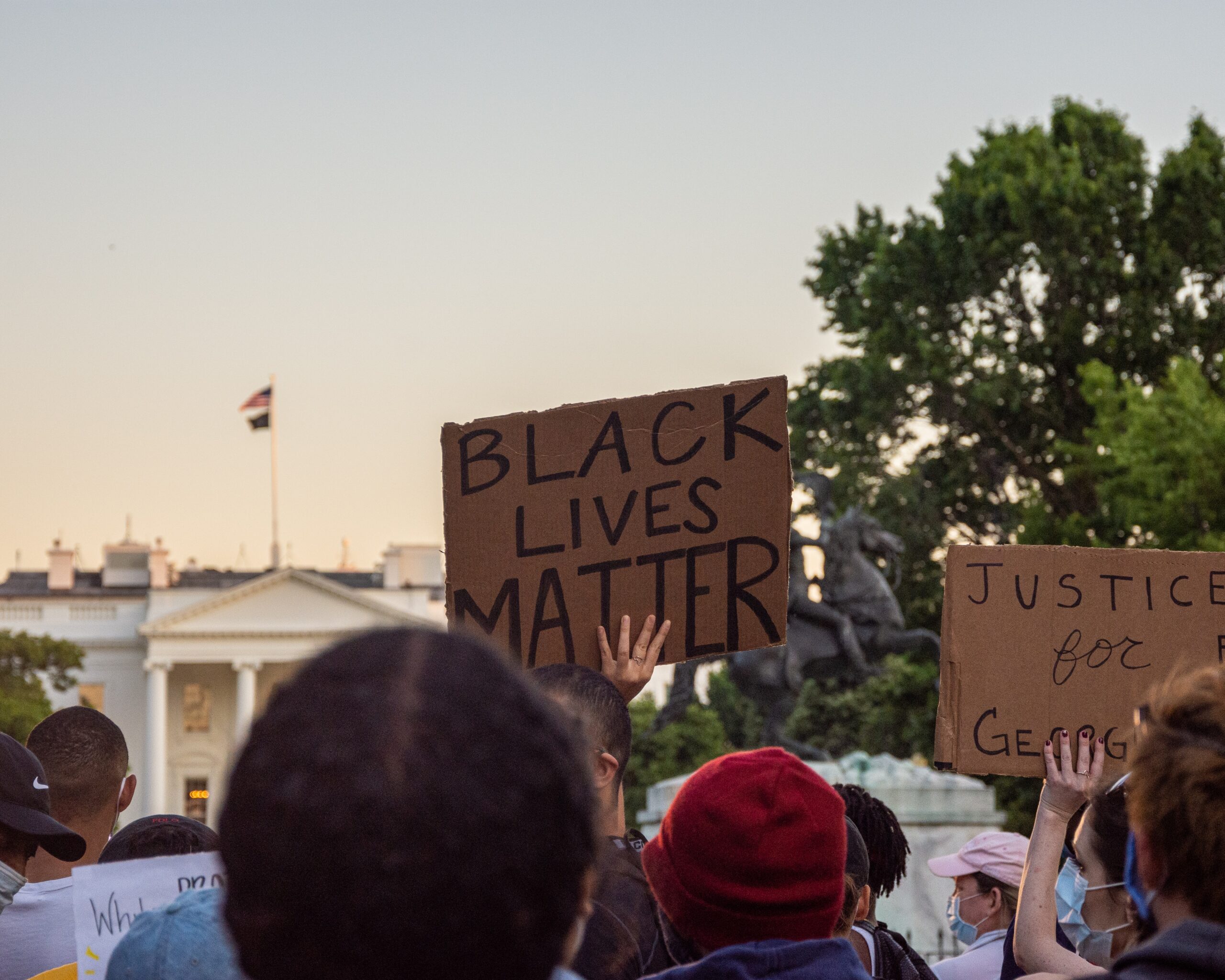Discrimination and human rights in the United States
By Sydney Sanders
This country spotlight refers to data published in 2023. For the most recent data, go to the Rights Tracker.
Racial injustice and discrimination in the United States is not only present, but pressing.
The murder of George Floyd in 2020, among others, focused global attention on the issues of racial injustice, discrimination, and police brutality in the United States. The mobilisation of the Black Lives Matter movement coupled with political protests that happened around the world, have begun to change the ways in which people inside and outside of the United States understand race and its role in how people are treated within US borders. These efforts brought widespread attention to the work those fighting racial discrimination in the US have been doing for decades.
However, the impact of racial discrimination extends farther than just the stories in the news. Racial and ethnic identity not only impact one’s physical safety in the United States, but their access to other human rights as well.
Although racial discrimination was the focus of most advocacy efforts in the years following 2020, discrimination does not only occur on the basis of race and ethnicity. People in the United States also face discrimination based on gender or sexual identity, social or economic status, citizenship status, ability, and more. The ways in which a person’s identity can impact their enjoyment of human rights is increasingly apparent when identities intersect across multiple at-risk groups.
Human rights data measured by the Human Rights Measurement Initiative (HRMI) help tell the story of discrimination in the US. By viewing injustice through the lens of human rights, we can better understand the full impact that discrimination can have on people in the United States.
Safety from the State Rights
HRMI’s Safety from the State data show how the US scores on five physical integrity rights. The United States receive a 5.4 out of 10 summary score for Safety from the State rights.
On a 0-10 scale, here’s how the United States score for each right:
Right to freedom from
- Arbitrary arrest: 5.3
- Forced disappearance: 8.0
- Death penalty: 4.9
- Extrajudicial execution: 4.4
- Torture and ill-treatment: 5.4
For all but one of these rights, the United States score in the “bad” category. This shows us that the US is not respecting and protecting the physical safety of its citizens.

However, not all people in the US are equally at risk of having these rights violated. HRMI asks local human rights experts which groups of people are particularly at risk of not enjoying their human rights.
For the right to freedom from arbitrary arrest, extrajudicial execution, and torture and ill-treatment, over 78% of US experts identified people of particular races as being especially vulnerable.
These experts also provided HRMI with context about who is distinctly at risk, noting specifically that people of colour, particularly Black men or people of Middle Eastern or Latin descent, immigrants, especially those detained by ICE at the southern United States border, and Indigenous men are all especially at risk. In 2021, respondents also identified that protestors, particularly those protesting against police violence were at risk for having their rights to be safe from the state violated.
The New York Times notes that police commonly use tear gas, pepper spray, and other projectiles like rubber bullets to curb protests against police brutality. However, some protests were more likely to be met with violence than others. The Guardian posits that police in the United States are three times more likely to use force against left wing protesters than right wing protesters. Protests for Black Lives Matter were disproportionately met with violence, indicating a clear disparity between how police respond to protests that challenge their actions against people of colour and those that do not.
The frequent identification of racial and ethnic minorities as at risk for having their safety from the state rights violated paint a picture of systemic racial and ethnic targeting by the state and state agents.
Racial injustice is one of the most significant and widespread issues in the United States. It impacts all aspects of people’s rights to be safe from the state. HRMI data paint a clear and undisputable picture of this reality.
Empowerment Rights
There are several ways at-risk groups can advocate for their human rights. From peaceful protesting to voting in elections, people in the US should be able to fight for their rights in ways afforded to them in international law. The US government has signed and ratified the International Covenant on Civil and Political Rights (ICCPR), meaning the US is legally obligated to respect, protect, and fulfil these rights for all of its citizens.
However, the rights protected by the ICCPR are not equally respected for all people. While the United States government has also signed and ratified the International Convention on the Elimination of All Forms of Racial Discrimination, meaning it has agreed to not practise discrimination and protect its citizen from being discriminated by others, the US has largely failed to enact laws and implement policies that actually work towards ending discrimination on a meaningful level.
The US scores slightly better at respecting Empowerment Rights than it does Safety from the State, receiving a summary score of 5.7 out of 10.
On a 0-10 scale, here’s how the United States scores for each right:
Right to
- Assembly and association: 6.3
- Opinion and expression: 5.8
- Participate in government: 5.4
These scores fall in the “fair” and “bad” categories. The United States’ empowerment score of 5.7 out of 10 suggests that while many people are enjoying their civil liberties and political freedoms (freedom of speech, assembly and association, and democratic rights), a significant number are not.

Which groups are especially at risk of not enjoying their civil liberties and political freedoms?
Those most frequently identified by human rights experts are people of particular races and people of particular ethnicities with 88% of respondents identifying these groups as being particularly at risk of having their right to assembly and association and right to participate in government violated, while 63% of respondents identified them for the right to opinion and expression.
In many cases, the same people who are likely to suffer violations of the rights to be safe from the state are suffering when it comes to empowerment as well, such as people of colour, Indigenous people, migrants and/or immigrants, and LGBTQIA+ people.
Human rights experts also provided HRMI with additional context on empowerment rights violations in the US. This year, experts focused heavily on discrimination against the LGBTQIA+ community, giving insight into the negative impact of anti-LGBTQIA+ legislation and policies happening throughout the country.
Racial injustice plays a significant role in the government’s restrictions on empowerment. In 2021, experts similarly noted that anti-protest laws target the Black Lives Matter movement and the government interfered in peaceful protests across the border, impacting asylum seekers. They explained that people of colour are targeted by laws that restrict voting rights and racial and ethnic minorities in some parts of the country were at particular risk.
We see that discrimination not only impacts people’s physical safety in the US, but also their ability to protest and advocate for their rights. The groups most in need of having their human rights defended are the ones who face the most restriction, pushback, and violence when doing so.
Quality of Life Rights
Civil and political rights and economic and social rights are interconnected and dependent on one another. Discrimination in the United States also has a large impact on the enjoyment of human rights that allow people an adequate standard of living and employment, or Quality of Life Rights.
For example, the Center for American Progress describes that, “historic and ongoing displacement, exclusion, and segregation prevent people of colour from obtaining and retaining homeownership, as well as accessing safe, affordable housing.”
Although many anti-discrimination movements tend to focus on safety from the state and empowerment rights, it is important to look at the enjoyment of quality of life rights from the lens of systemic injustice.
HRMI quantifies how well a country is fulfilling its economic and social rights duties by looking at what they are achieving compared to what we calculate they could achieve at that country’s income level. Every country can achieve a score of 100% if they use their available resources effectively. Less than 100% suggests improvement is needed and possible.
Out of 100%, here are the United States’ scores:
Right to
- Education: 80.4%
- Food: 88.3%
- Health: 80.4%
- Work: 63.5%
None of the US’ scores fall in the “good” category. The US could achieve much more to guarantee a good quality of living for its people, but they are not using their available resources to meet their economic and social rights duties.

People of particular races and ethnicities were consistently identified by human rights experts as being particularly at risk of having their quality of life rights violated.
Other groups identified are Indigenous people, migrants and/or immigrants, people who are homeless, people with low social or economic status, children, and LGBTQIA+ people.
The prevalence of these people groups, regardless of the right, speaks directly to who gets to enjoy their human rights in the United States and who does not. The data describes an institutionalised system of oppression and discrimination that impacts a variety of different identities and prevents particular groups of people from enjoying their full set of human rights, as set out in US law.
There is a variety of solutions being offered by American people to approach these issues. Many people agree that change needs to occur on an institutional level. Pew Research Center argues, “These solutions range from overhauls of policing practices and the criminal justice system to civic engagement and reparations to descendants of people enslaved in the United States.” Organisations throughout the US are working towards eliminating discrimination, and in the meantime, lessening its impact on the enjoyment of human rights.
HRMI data clearly show that specific groups of people in the United States, such as people of colour, Indigenous people, and migrants and/or immigrants, are especially at risk of not having their human rights respected, protected, or fulfilled. Institutionalised oppression, racism, and discrimination in the US impacts these groups by consistently and systematically placing restrictions on the enjoyment of their rights. Governments and institutions need to take serious steps to tackle these issues.


